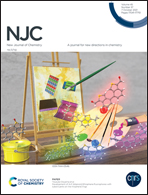A sustainable strategy for the remediation of oil/water separation using polybenzoxazine/stearic acid functionalized porous carbon†
Abstract
Superhydrophobic and superoleophilic polybenzoxazine-stearic acid based melamine sponge exhibiting an excellent oil/water separation property was fabricated by a facile route. The fabrication process involves the reduction and in situ polymerization of melamine sponge coated with benzoxazine and porous carbon/stearic acid. By employing this surface modification, the hydrophilic melamine sponge is converted into a superhydrophobic and superoleophilic material. The curing reactions occurring during the polymerization process are monitored by FT-IR and DSC analyses. Surface morphological studies have indicated that by producing hierarchically rough structures through low surface free energy polybenzoxazine, the surface composition of the melamine sponge can be tuned and its wettability can be interchanged as well. Furthermore, the modified melamine sponge exhibits fast and efficient oil/water separation and has excellent stability even after 20 cycles of usage. Therefore, this approach provides a new insight into the design and development of polybenzoxazine treated melamine sponge for industrial oil/water pollution treatments.



 Please wait while we load your content...
Please wait while we load your content...